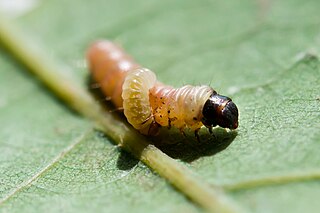
Schreckensteinia is a moth in the family Schreckensteiniidae.
Anthistarcha is a genus of moth in the family Gelechiidae.

Phthorimaea is a genus of moths in the family Gelechiidae. Species include the potato tuber moth, Phthorimaea operculella.
Ptychovalva is a genus of moth in the family Gelechiidae.
Moca is a genus of moths in the family Immidae. The genus was erected by Francis Walker in 1863.

Dendrolimus is a genus of moths in the family Lasiocampidae. The genus was erected by Ernst Friedrich Germar in 1812.
Megalotica is a genus of moths in the family Geometridae described by Zimmerman in 1958.
Dryadaula are a genus of moths belonging to the family Tineidae. It was described by Edward Meyrick in 1893, and it belongs to the subfamily or family Dryadaulidae, according to most recent taxonomies.

Snellenia is a genus of moths in the family Stathmopodidae.
Ussara eurythmiella is a species of sedge moth in the genus Ussara. It was described by August Busck in 1914. It is found in Panama.
Cyphothyris pyrrhophrys is a moth in the family Cosmopterigidae. It was described by Edward Meyrick in 1932. It is found on New Guinea.
Himmacia is a genus of moths of the family Depressariidae.

Psilocorsis is a genus of moths of the family Depressariidae.
Agonopterix baleni is a moth in the family Depressariidae. It was described by Zeller in 1877. It is found in Colombia.
Agonopterix cynarivora is a moth in the family Depressariidae. It was described by Edward Meyrick in 1932. It is found in Morocco.
Cryptolechia metacentra is a moth in the family Depressariidae. It was described by Edward Meyrick in 1914. It is found in Taiwan.
Cryptolechia percnocoma is a moth in the family Depressariidae. It was described by Edward Meyrick in 1930. It is found in Brazil.
Cryptolechia fenerata is a moth in the family Depressariidae. It was described by Edward Meyrick in 1914. It is found in Taiwan.
Ethmia infelix is a moth in the family Depressariidae. It was described by Edward Meyrick in 1914. It is found in Turkey (Mardin) and northern Iraq (Kurdistan).
Rectiostoma leuconympha is a moth in the family Depressariidae. It was described by Edward Meyrick in 1921. It is found in Brazil.







